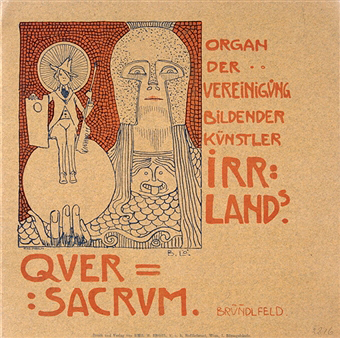
304 pages Format: 278 x 288 mm Texts: Rasheed Araeen, Pierre Bal-Blanc, Anthony Hudek, Dean Inkster, Sanja Ivekovic, Grzegorz Kowalski, Elisabeth Lebovici, Isidoro Valcrcel Medina, Karin Mihatsch, Philippe le Moal, Andrs Plffy, Gianni Pettena, Emilio Prini, Anka Ptaszkowska, Pierre Restany. However, its cupola of metal openwork with abundant floral ornaments was unmistakably Art Nouveau in quality. Ver Sacrum / The Death of the Audience Artists Books/Catalogues accompanying the exhibition. Bold and simple, it consisted of juxtaposed huge blocks and had a particular orientalizing aspect. The first issue was released in January of 1898 with its arrival being announced in leading newspapers as a subscription journal. It’s advances in graphic design, typography and illustration set the model for later art magazine design and continues to influence magazine and book design to this day. This building was finished in 1898 and caused a sensation in Vienna. From Ver Sacrum (The Sacred Spring) Otto Wagner described the goal of the Vienna Secession as to show the modern man his true face. Ver Sacrum (‘Sacred Spring’ in Latin) was the official magazine of the Vienna Secession from 1898 to 1903. expressions paired with theoretical expressions (essays about art and art theory) were a vital. (Ver Sacrum i For the Vienna Secessionists, visual art and other artistic 6). Immediately Olbrich started to design their headquarters. Keywords: artistic selfhood and convergence, Vienna Secession, Ver Sacrum, cultural politics and the rhetoric of the arts, Kunstempfinden, Viennese Modernism. Joseph Maria Olbrich was an influent architect of the Austrian Art Nouveau and one of the founders of the Vienna Secession.


These shows were scheduled by the Association of Austrian Artists, which ran the Kunstlerhaus (Artists’ House) favoring the conservative artists who built up a majority of its members, generally discouraging efforts in the decorative and applied arts.

The Secession grew out of a dissatisfaction of artists with the system of expositions of contemporary artworks in the city during the 1890s. Image source: by Bibliothèques de Nancy- Patrimoine


 0 kommentar(er)
0 kommentar(er)
